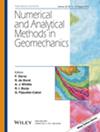Modeling Temperature‐ and Rate‐Dependent Behavior of Soft Soils: A Thermo‐Visco‐Hypoplastic Approach
IF 3.4
2区 工程技术
Q2 ENGINEERING, GEOLOGICAL
International Journal for Numerical and Analytical Methods in Geomechanics
Pub Date : 2025-03-23
DOI:10.1002/nag.3976
引用次数: 0
Abstract
Temperature effects become important in a number of geotechnical applications, such as nuclear waste disposal facilities, buried high‐voltage cables, pavement, energy geostructures and geothermal energy. On the other hand, soft soils act time‐ and strain rate dependent. Both temperature and strain rate influence soil behavior, affecting stiffness, strength, and deformation even under constant stress levels. A model to predict temperature and loading rate effects on soil behavior is presented in this article. The model is based on a simple visco‐hypooplastic model for clays and encompasses key aspects of coupled rate‐ and temperature‐dependent soil behavior such as (partially irreversible) thermal expansion, heating‐induced irreversible compression, stress history, drained heating/cooling cycles, as well as mechanical and thermal creep, incorporating isotachs, and isotherms.模拟温度和速率对软土行为的影响:热-粘-发育不良方法
温度效应在许多岩土工程应用中变得非常重要,例如核废料处理设施、地埋高压电缆、路面、能源土工结构和地热能。另一方面,软土的作用依赖于时间和应变率。温度和应变率都会影响土壤的行为,即使在恒定的应力水平下也会影响刚度、强度和变形。本文提出了一个预测温度和加载速率对土壤特性影响的模型。该模型基于一个简单的粘土粘塑性模型,包含了速率和温度相关的土壤行为的关键方面,如(部分不可逆)热膨胀、加热诱导的不可逆压缩、应力历史、排水加热/冷却循环,以及机械和热蠕变,包括等温线和等温线。
本文章由计算机程序翻译,如有差异,请以英文原文为准。
求助全文
约1分钟内获得全文
求助全文
来源期刊
CiteScore
6.40
自引率
12.50%
发文量
160
审稿时长
9 months
期刊介绍:
The journal welcomes manuscripts that substantially contribute to the understanding of the complex mechanical behaviour of geomaterials (soils, rocks, concrete, ice, snow, and powders), through innovative experimental techniques, and/or through the development of novel numerical or hybrid experimental/numerical modelling concepts in geomechanics. Topics of interest include instabilities and localization, interface and surface phenomena, fracture and failure, multi-physics and other time-dependent phenomena, micromechanics and multi-scale methods, and inverse analysis and stochastic methods. Papers related to energy and environmental issues are particularly welcome. The illustration of the proposed methods and techniques to engineering problems is encouraged. However, manuscripts dealing with applications of existing methods, or proposing incremental improvements to existing methods – in particular marginal extensions of existing analytical solutions or numerical methods – will not be considered for review.

 求助内容:
求助内容: 应助结果提醒方式:
应助结果提醒方式:


